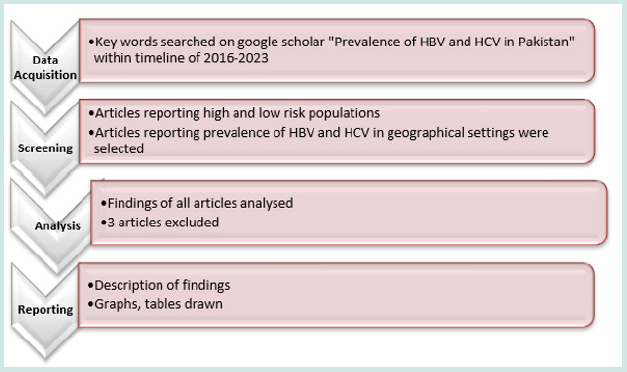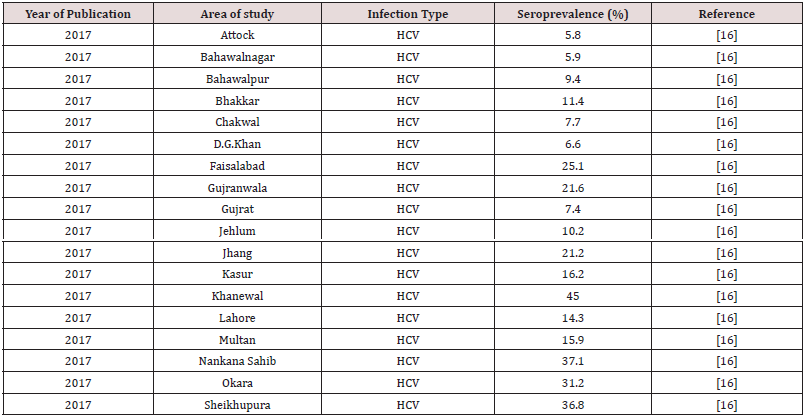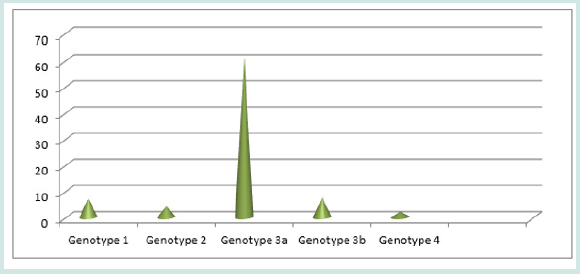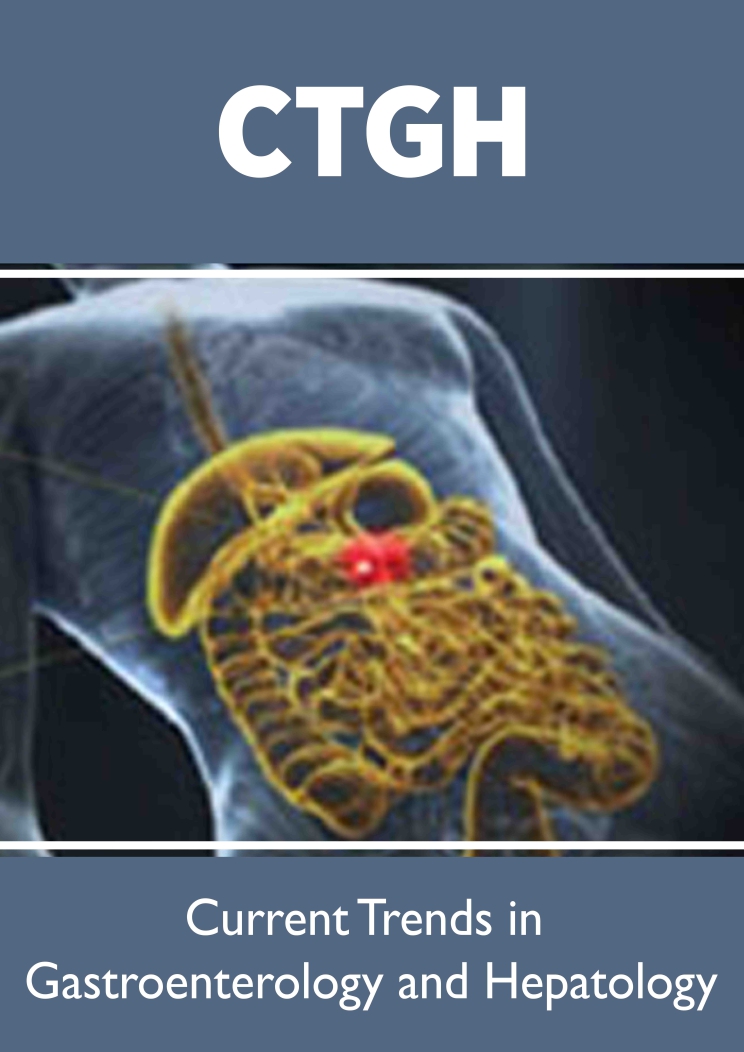
Lupine Publishers Group
Lupine Publishers
Menu
ISSN: 2641-1652
Research Article(ISSN: 2641-1652) 
Prevalence of Hepatitis B and Hepatitis C in Pakistan- An Updated Characterization Volume 4 - Issue 3
Ghazala Rubi1*, Maria Jalil2, Muhammad Amir Bashir3, Sobia Ashraf4, Zainab Javaid5 and Ahmad Shuja Watto6
- 1Director Research & Head of Molecular Genetics Pathology, Lahore General Teaching Hospital, Lahore, Pakistan
- 2Department of Biochemistry, Bahauddin Zakariya University, Multan, Pakistan
- 3Medical Officer, Lahore General Hospital, Lahore, Pakistan
- 4Professor of Hematology, UCMD, University of Lahore, Pakistan
- 5Student Central Research Lab, Lahore General Hospital Lahore, Pakistan
- 6Resident, Central Park Teaching Hospital, Lahore, Pakistan
Received: August 22, 2023; Published: August 28, 2023
*Corresponding author: Ghazala Rubi, Director Research & Head of Molecular Genetics Pathology, Lahore General Teaching Hospital, Lahore, Pakistan
DOI: 10.32474/CTGH.2023.04.000190
Abstract
Background: Hepatitis B and C are the high burden diseases, infecting 62-79 million people worldwide. Pakistan is reporting alarmingly high numbers of seroprevalence and active infection of HBV and HCV in population. Several risk factors involve IV drug abuse, surgical and dental procedures, sexual contact, less awareness about vaccination, shaving kits, , placental transmission, improperly sterilized medical equipment and unscreened blood transfusions. Our present study is an attempt to assess prevalence of HBV and HCV in Pakistan during 2016-2023.
Methods: Literature survey about the populations being affected by HBV and HCV was done by using the search tool Google Scholar during the abovementioned timeline. Articles were screened for the relevant data. Descriptive and qualitative analysis was done by the available data.
Results: Prevalence of HBV and HCV was highest in Sindh (7%), followed by KPK (6.6%) and then Punjab (5.6%) and Baluchistan and F.A.T.A being less infected. High risk and low risk populations were identified statistically, and genotypic distribution was also characterized.
Conclusion: Alarming rise in HBV and HCV signals the dire need of better treatment and preventive initiatives to be taken by Government and individuals.
Hepatitis B; hepatitis C; liver infections; blood-borne infection
Introduction
Hepatitis is an inflammatory disease of the liver. Hepatitis B virus (HBV) is a double stranded DNA virus that affects about 4.55 million people of Pakistan. Whereas Hepatitis C virus (HCV) is a single stranded RNA virus that inflicts 8.74 million Pakistani individuals [1]. Both viral diseases are pathologically alarming as later stages lead to hepatocellular carcinoma and liver cirrhosis. Both viral infections are found to cause 1.34 million deaths globally [2]. Children a more prone to acquire this infection and about 90% of newborns have hepatitis [3]. Socio-economic status and genotypic distribution vary with geographical settings and so the prevalence of HBV and HCV infections.
Methods
Selected available data of epidemiology of HBV and HCV in Pakistan was reviewed on Google scholar from 2016-2023. The work is presented to aware the population of Pakistan about the prevalence of HBV and HCV (the two high burden liver infections) to promote better hygiene and vaccination practices to undo the detrimental impacts.
Data acquisition
Key words “Prevalence of Hepatitis B and C in Pakistan’ were searched on Google scholar and timeline was adjusted to systematically review relevant studies done during 2016-2023.
Screening of Data
All the obtained articles were screened thoroughly to obtain the data regarding the high risk and low risk populations and prevalence of HBV and HCV in different areas of Pakistan.
Data analysis and organization
All the statistical data was analyzed, including maps and graphs. Few studies reported the studies on HAV and HDV and comorbidities and were excluded to only focus on the epidemiology of HBV and HVC. All the findings of included articles were analyzed and organized, based on the categories:
a) High risk and low risk populations:
b) Geographical prevalence of HBV and HCV
c) Genotypic distribution of types and sub-types of HBV and HVC.
Reporting the findings
Findings were keenly described and reported in the form of tables, graphs and diagrams.
Our methodology is shown in the flowchart given in Figure 1.
Results
Our findings give a clear picture of prevalence of HBV and HCV during the 2016-2023 in Pakistan. We have organized our findings into High risk, low risk and intermediate risk population. Lowrisk population includes the general population which includes pregnant women, blood donors, children, refugees.
Low and High-risk populations
Low-risk population (General population)
Pregnant women: Complications of pregnancy elevate with this viral infection like placental abnormalities, gestational diabetes, preterm labor and even death [4]. Estimated risk of gallstone formation is about 6% in pregnant women with hepatitis [5]. HBV infection passes on from mother to child natal at birth and postnatally via breastfeeding [6]. Viremic mothers can transmit HCV infection to their newborns at a probability of 3.2% [7]. Higher prevalence of this infection in pregnant women owe to surgeries, injections and blood transfusions. Findings of studies that have been carried out to investigate the prevalence of HBV and HCV in Pakistani pregnant women are tabulated in Table 1.
Blood donors: Blood donors are more susceptible to acquire this blood-borne infection than non-blood donors as they encounter several transfusion transmissible infections while syringe piercing for donating blood. A review reports HBV weighted average of 11 studies to be 2.41% while HCV weighted average of 13 studies was 3.31% as estimated till 2019 [11].
High risk clinical population
Thalassemia Patients: Almost 5-7% population is suffering from this hereditary disease in Pakistan. Owing to the anemic condition of such patients, blood transfusion on regular basis is mandatory. Blood transfusions become a vector of HBV and HCV infection in Thalassemic patients. A recent study reports the prevalence of HBV in thalassemic patients at CMH, Rawalpindi during 2021-2022. A study revealed that 5 patients out of 100 patients had active HBV [12].
Dental Procedures: Seropositivity of HBV and HCV was investigated in Azad Jammu and Kashmir, Pakistan during 2022. Dental procedures were found to be a major contributor to these infections. 107 cases out of 317 participants (i.e., 61.9%) positive HBV patients had dental surgeries [13]. Other high-risk populations include patients of hemophilia, hemodialysis and all others who receive blood transfusions. Barbers are also at high risk of acquiring HBV and HVC infection via razors, combs, blades etc.
Intermediate Risk population: Health workers, Patients of Diabetes mellitus, prisoners and household contacts of HCVinfected patients are at intermediate risk. Reuse of needles, improper sterilization of medical instruments, unscreened blood, tattooing and nose/ear piercing are the intermediate risk factors.
PWID (People who inject drugs): People who are addicted to drugs inject themselves frequently with reused syringes. They acquire HIV and other infections like HCV and HBV. An investigation reported that 5% of PWID with HIV were positive for HBV and 50% were having HCV [14]. People with chronic liver diseases who are hospitalized are also at risk to get viremic with HCV and HBV because of exposure to unhygienic environment. H. Qureshi et al. reported 10-46% CLD patients had HBV and 40-86% had anti-HCV in their study about the prevalence of HBV and anti-HCV in Pakistan [15].
Geographical prevalence of HBV and HCV in Pakistan
Prevalence of these infectious ailments varies in different geographical settings. A study conducted retrospective analysis to estimate the serological prevalence of HCV in population of Punjab, Pakistan in 2017. 5 districts: Khanewal, Faisalabad, Okara, Sheikhupura and Nankana Sahab were identified with higher seroprevalence [16]. The seroprevalence of districts are mentioned in Table 2. Ahmad M et al. screened 300 individuals from Arifwala, Punjab, Pakistan for HBV and anti-HCV and found the prevalence of HBV and HCV as 10% and 14% respectively [17]. Mahmud et al. characterized the HCV epidemic in Pakistan and his findings about prevalence of HCV in provinces of Pakistan are mentioned in Table 3 [18].
Genotypic distribution
6 major HCV genotypes (1-6) and few sub-types (denoted alphabetically like 3a) have been known [19]. These genotypes are distributed differently in ethnic groups and geographical settings of Pakistan. Several studies have characterized the HCV genotypic distribution in Pakistan. Umer M. et al. conducted a systematic survey to characterize HCV genotypes and results of each genotype with percentage are shown in chart of Figure 2 [20]. Another study investigated the genotypic distribution in responders, relapsers and non-responders. It was found that 84% of Genotype 3a was common in responders, Genotype 1a was abundant in relapsers (66%) [21].
Conclusion
Pakistan’s epidemic of HBV and HCV is rising alarming, infecting newborns, pregnant women, individuals getting blood transfusions, barbers, health professionals and prisoners. Poor hygienic habits and less vaccination awareness render HBV and HCV the havoc for the population. Genotypic distribution and geographical prevalence are highlighted in the study. Scale up of preventive and treatment measures need to be done to eliminate this blood-borne killer.
References
- Zahid Aasia, Hina Awais, Fareeha Bashir, Talha Mannan, Ayesha Afzaal, et al. (2023) Prevalence of Hepatitis B&C in Pregnant females &Transmission through Sporadic Source and Dental Source among Pakistani Population: A Brief Review. Pakistan Journal of Medical & Health Sciences 17(2): 8-8.
- Ahmad Mahtab, Muhammad Kamran, Haroon Amin, Saba Zafar, Samra Asghar, et al. (2022) Prevalence and Risk Factors of hepatitis B and C infections in general population of Tehsil Arifwala: Hepatitis B and C Infections in General Population. Pakistan BioMedical Journal 5(6): 111-115.
- World Health Organization (2017) Hepatitis B fact sheet. WHO, Geneva, Switzerland.
- Saadat Parveen, Abdul Latif, Ashraf Muhammad (2014) Seroprevalence of hepatitis C virus [HCV] in southern Punjab. Virtual Health Library 25(11): 2-4.
- Saleh Mohammed Abdullah (2018) Prevalence of Hepatitis B and C virus infection and their co-relation with hematological and hepatic parameters in subjects undergoing Premarital Screening in the Jazan Region, Kingdom of Saudi Arabia. Pak J Med Sci 34(2): 316-321.
- Ambreen Ehsan, Helen Robert, Ikram Nabi, Maryam Abbas (2020) Prevalence of hepatitis B and C in female population reporting for antenatal screening at combined military hospital hhydraabad sindh, pakistan. Pakistan Armed Forces Medical Journal 70(2): 385-89.
- Huma Qureshi (2014) The evidence of mother to child transmission of hepatitis B virus infection in Pakistan and the need for hepatitis B immunization policy change. J Pak Med Assoc 64(8): 978.
- Hasan Mahmood, Riffat Raja (2017) Risk factors of hepatitis C in Pakistan. Gastroenterol Hepatol Open Access 7(6): 348-353.
- Ahmad R Khan, Salma Waqar, Zainab Rafiq, Rizwan Ullah, Muhammad Hayyan Wazir, et al. (2022) Frequency of acute viral hepatitis A, B, C, and E in pregnant women presenting to Hayatabad medical complex, Peshawar, Pakistan. Cureus 14(4): e24208.
- Naseeb Shazia, Shaista Rashid, Sania Dehar (2023) The Frequency of Hepatitis B and C and its Risk Factors in Pregnant Women Presenting at Jinnah Postgraduate Medical Center, Karachi: Hepatitis B and C and its Risk Factors in Pregnant Women. Pakistan Journal of Health Sciences 4(3): 83-87.
- Shahid Mehmood, Hassan Raza, Farhan Abid, Nouman Saeed, Hafiz Muzzammel Rehman, et al. (2020) National prevalence rate of hepatitis B and C in Pakistan and its risk factors. Journal of Public Health 28(1): 751-764.
- Hussain, Akber, et al. (2023) Frequency of Hepatitis B in Thalassemia Major Patients. Journal of Rawalpindi Medical College 27(1).
- Muhammad Abdul Quddus, Rizwan Saeed, Arslan Shahzad, Muhammad Nadeem, Jhangir Zaib, et al. (2023) Factors associated with seropositivity of Hepatitis B & C: A case control study at Azad Jammu and Kashmir. Journal of Rawalpindi Medical College 27(1): 16-21.
- Sana Mansha, Muhammad Imran, Amir Miraj Ul Hussain Shah, Muhsin Jamal, Fayyaz Ahmed, et al. (2017) Hepatitis B and C virus infections among human immunodeficiency virus-infected people who inject drugs in Lahore, Pakistan. Viral Immunol 30(5): 366-370.
- H Qureshi, K M Bile, R Jooma, S E Alam, H U R Afridi (2010) Prevalence of hepatitis B and C viral infections in Pakistan: findings of a national survey appealing for effective prevention and control measures. East Mediterr Health J 16: 15-23.
- Asma Ahsan, Adnan Zafar Khan, Hasnain Javed, Shaper Mirza, Safee Ullah Chaudhary, et al (2019) Estimation of hepatitis C prevalence in the Punjab province of Pakistan: a retrospective study on general population. PLoS One 14(4): e0214435.
- Mahtab Ahmad, Muhammad Kamran, Haroon Amin, Saba Zafar, Samra Asghar, et al. (2022) Prevalence and Risk Factors of hepatitis B and C infections in general population of Tehsil Arifwala: Hepatitis B and C Infections in General Population. Pakistan BioMedical Journal 5(6): 111-115.
- Sarwat Mahmud, Zaina Al Kanaani, Laith J Abu-Raddad (2019) Characterization of the hepatitis C virus epidemic in Pakistan. BMC Infectious Diseases 19(1): 1-11.
- WHO (2003) Epidemic and pandemic alert and response, Hepatitis C virus.
- Muhammad Umer, Mazhar Iqbal (2016) Hepatitis C virus prevalence and genotype distribution in Pakistan: Comprehensive review of recent data. World J Gastroenterol 22(4): 1684-1700.
- Rubi Ghazala, Muhammad Aslam Khan (2017) Gene Polymorphism of Responder, Relapser and Non-Responder of Chronic Hcv Infection among Ethnic Tribes of Punjab Pakistan. Clin Immunol Res 1(1): 1-5.

Top Editors
-

Mark E Smith
Bio chemistry
University of Texas Medical Branch, USA -

Lawrence A Presley
Department of Criminal Justice
Liberty University, USA -

Thomas W Miller
Department of Psychiatry
University of Kentucky, USA -

Gjumrakch Aliev
Department of Medicine
Gally International Biomedical Research & Consulting LLC, USA -

Christopher Bryant
Department of Urbanisation and Agricultural
Montreal university, USA -

Robert William Frare
Oral & Maxillofacial Pathology
New York University, USA -

Rudolph Modesto Navari
Gastroenterology and Hepatology
University of Alabama, UK -

Andrew Hague
Department of Medicine
Universities of Bradford, UK -

George Gregory Buttigieg
Maltese College of Obstetrics and Gynaecology, Europe -

Chen-Hsiung Yeh
Oncology
Circulogene Theranostics, England -
.png)
Emilio Bucio-Carrillo
Radiation Chemistry
National University of Mexico, USA -
.jpg)
Casey J Grenier
Analytical Chemistry
Wentworth Institute of Technology, USA -
Hany Atalah
Minimally Invasive Surgery
Mercer University school of Medicine, USA -

Abu-Hussein Muhamad
Pediatric Dentistry
University of Athens , Greece

The annual scholar awards from Lupine Publishers honor a selected number Read More...







